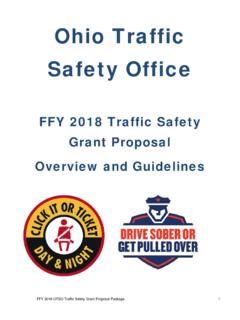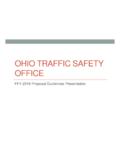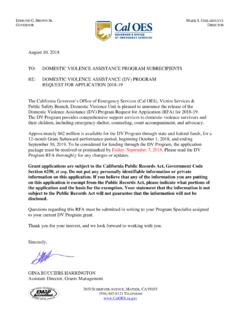Transcription of FFY 2018 Traffic Safety Project Proposal Overview ...
1 1 FFY 2018 Traffic Safety Project Proposal Overview & instructions What is Target Zero ? Washington is building Traffic Safety partnerships throughout the state to align priorities and leverage resources to improve Traffic Safety . The Target Zero Plan is the result of this work and represents Washington s strategic roadmap for eliminating Traffic fatalities and serious injuries by the year 2030. The Target Zero Plan provides a comprehensive framework with specific priorities, goals, and strategies. Successful grant proposals are aligned with the Target Zero priorities and utilize its proven strategies or consist of innovative strategies with an accompanying evaluation plan. The 2016 revised Target Zero Plan is available at What are Target Zero Priority Areas? The Target Zero Plan prioritizes Traffic Safety issues into three distinct levels.
2 The three priority levels are determined based on the percentage of statewide Traffic fatalities and serious injuries associated with each factor. Currently, Priority 1 has five main emphasis areas: Impairment involved, Speeding Involved, Lane Departure, Intersection related, and Young Drivers. In addition, the Target Zero Plan also notes the importance of Decision and Performance Improvement areas ( Traffic Data Systems, Emergency Medical Services and Trauma Response, and Evaluation, Analysis, and Diagnosis) by labeling them as Priority 1. Priority 2 includes Distraction Involved, Unrestrained occupants, Unlicensed driver involved, Motorcyclists, Pedestrians, and Older driver involved. Priority 3 consists of issues or topic areas associated with fewer fatalities and serious injuries. In addition to the statewide priority areas listed in Target Zero, a local county or municipality may have data that shows specific percentages of Traffic fatalities in that county or city for one or more focus areas.
3 Projects that involve higher priority areas (either using statewide or county data) will receive special consideration for funding. What are Proven or Evidence-Based Strategies? Research and evaluation studies have validated the effectiveness of certain strategies for improving Traffic Safety . These strategies are referred to as Proven. The Target Zero Plan includes dozens of these strategies which have been proven effective either through national research studies or sound Project evaluation efforts. Those strategies that lack research evidence of effectiveness are listed in Target Zero as either Recommended or Unknown. Project proposals that include Proven strategies will receive extra consideration for funding while those employing Recommended, Unknown, or other strategies will be considered based on Project merit and planned outcomes.
4 If your Proposal includes an innovative demonstration Project for which no research exists to support its effectiveness, your Project must contain a strong evaluation plan to assess the effectiveness of the Project at its conclusion. In addition to reviewing the Traffic Safety strategies contained in the Target Zero Plan, you may find it helpful to explore strategies contained in the following documents: Countermeasures that Work, a joint publication by the National Highway Traffic Safety Administration (NHTSA) and the Governors Highway Safety Association (GHSA) 2 American Association of State Highway & Transportation Officials (AASHTO) Strategic Highway Safety Plan What is the process Washington Traffic Safety Commission (WTSC) uses to award grants ? Once the deadline for submission of proposals has closed, WTSC staff will evaluate and score the proposals.
5 Scoring is based on the merits of the answers provided to the primary Proposal questions. Once WTSC staff has concluded its review and developed an overall recommendation for funding, a multi-disciplinary advisory committee will review the proposals, consider the WTSC staff Proposal , and develop a recommendation for the WTSC Commissioners to consider. The WTSC Commissioners will make final funding decisions at the Commission s April 20, 2017 meeting. WTSC will contact each applicant following the April Commission meeting to notify applicants of the status of their Proposal . From May to August 2017, WTSC staff will work with award recipients to execute an Interagency Agreement for the Project period of performance October 1, 2017, through September 30, 2018 . What is the schedule for the grant process?
6 Event Date (subject to change) Notification of available grants is sent December 21, 2016 Applicant questions/ Proposal preparation period December 21, 2016 - February 10, 2017 Proposals due to WTSC February 10, 2017 WTSC evaluates proposals February 11, 2017 - March 30, 2017 Advisory Committee reviews proposals April 11, 2017 Commissioner review of funding Proposal April 20, 2017 Notify applicants of selection April 24, 2017 - May 5, 2017 Negotiate and finalize contracts May 5, 2017 - September 30, 2017 Project start date October 1, 2017 Project end date September 30, 2018 What is the deadline for submissions? Your Proposal must be received by WTSC no later than 5 PST, February 10, 2017. Late proposals will not be accepted. How will I know if WTSC has received my submission? WTSC will send each applicant an email acknowledging receipt of the Proposal in February 2017.
7 If you do not receive a notice, please contact WTSC at (360) 725-9860 to confirm that your Proposal was received. Who is eligible to receive WTSC grant funds? Washington State agencies Federally-recognized tribal governments Cities, counties, and their sub-agencies Non-profit organizations with existing IRS 501(c)(3) status Public schools (and private schools with non-profit status) What are the minimum qualifications to receive a grant? Eligible agencies or organizations must be able to: 3 Manage public funds efficiently and ethically Collaborate with other public, private, and non-profit organizations Effectively monitor and evaluate the outcomes of a Project Adhere to the State and Federal Terms & Conditions of the grant agreement, including submitting quarterly Project reports to the WTSC How are funds distributed?
8 WTSC distributes funds on a cost reimbursement basis only. WTSC does not make payments in advance or in anticipation of goods or services. How much funding can I request? Typically, grants range in amounts from $5,000 to $150,000. What types of costs are allowable under this grant? All costs under this grant must follow the Federal Office of Management and Budget guidelines and 2 CFR Part 200 Subpart E -- Cost Principles. # Allowable Project costs include: Cost to implement strategies designed to address Traffic Safety problems Equipment and materials Goods and services Training and travel directly related to Project goals What types of costs are not allowable under this grant? All projects must follow appropriate state and federal funding regulations. Federal regulations prohibit the use of these funds for office furniture, gifts, entertainment, roadway construction, or roadway maintenance.
9 Roadway construction and maintenance includes the purchase of permanent road signs, Traffic signals, Variable Message Signs, reflective paint, in-pavement flashing beacons, and motion-activated pedestrian signals. Funds may not be used for signal improvements including timing, retroreflective tape and back plates, and adaptive signal control. Funds may not be used for managing roadway access, implementing road diet countermeasures, new or modified turn lanes and signals, pavement markings, illumination, sight distance improvements, guardrail, rumble strips, or high friction pavement. Federal regulations also prohibit supplanting, using these funds to replace routine or existing state and local expenditures or using these funds to conduct activities required by RCW, WAC, or other statute. Are indirect costs allowed?
10 Yes. However, the WTSC strives to limit the use of funds to direct costs for Traffic Safety projects. In a few cases, the WTSC approves indirect costs necessary to realize the objectives of a promising Traffic Safety Project . In order to request the inclusion of indirect costs on a grant award, the organization must provide the WTSC a copy of a cost allocation plan approved by the organization s federal cognizant agency. These cost allocation plans outline negotiated indirect cost rates as a percentage to be applied to specific Project expenditures such as salary 4 and benefits. Indirect cost rates may vary by Project expenditure, and must be applied appropriately to each expenditure for which indirect costs are requested. Rules governing the application of indirect costs are found in 2 CFR Part # Can funds for engineering projects be requested?









